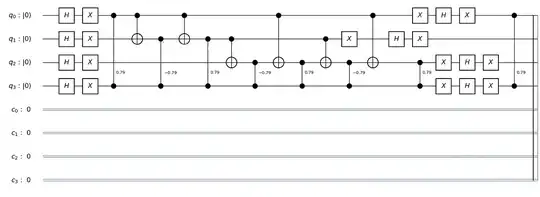You can figure out 3) and 5) using the formula given by @MartinVesely in the page you linked to.
As was discussed in the post or the matrix of a CU gate with a control and a target separated by $k$ qubits is as follows.
\begin{equation}
CU_k =
\begin{pmatrix}
I_\frac{N}{2}& O_\frac{N}{2} \\
O_\frac{N}{2} &I_\frac{N}{4} \otimes U
\end{pmatrix}
\end{equation}
Here $N=2^{k+2}$, $O$ is the all-zero matrix and $I$ is the identity. The gates in your diagram seem to be Controlled U1 gates where U1 is represented by the following unitary.
\begin{equation}
U1(\lambda) =
\begin{pmatrix}
1& 0 \\
0 &e^{i \lambda}
\end{pmatrix}
\end{equation}
Now we see there are two qubits between the control and the target qubit of the CU1 gate. Therefore $k=2$ and $N=16$). Substituting in $N=16$ and $U=U1$ we get the following...
\begin{equation}
CU1_{k=2} = \begin{pmatrix}
I_8& O_8 \\
O_8 &I_4 \otimes U1
\end{pmatrix}
\end{equation}.
If you have the patience you can write down the full $16 \times 16$ matrix from this by expanding the four entries. Maybe you could factorise this matrix into a tensor product of $2 \times 2$ matrices. I'd have to think about it more as I'm not sure there is a nice form.
Edit: Similarly to Frank I calculated the unitary (I did the first CU1 gate in the circuit). Wouldn't want to do this by hand.

I did this symbolically with pytket. Note the factor of $\pi$ due to different conventions. $(\lambda = \pi \theta)$
from pytket import Circuit, OpType
from pytket.utils import circuit_to_symbolic_unitary
from sympy import Symbol
theta = Symbol("theta") #theta = 1 / 4 in your example
circ = Circuit(4).add_gate(OpType.CU1, [theta], [0, 3])
circuit_to_symbolic_unitary(circ)

